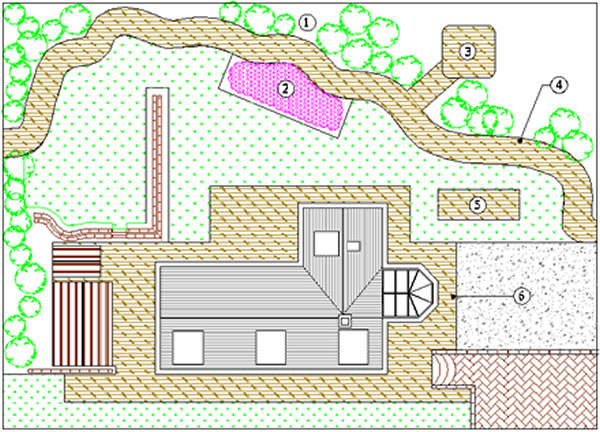Non-chemical Methods of Tick Control for the Domestic Environment
Creating a buffer zone in your garden.
Ticks need a humid environment to thrive. This humidity is created by plant cover and plant debris (e.g. leaf litter). This results in a micro-climate that is suitable for ticks. Strategically using paving, wood chip and gravel around your property can reduce the humidity, keeping the ticks at a distance from housing and recreational areas.
Buffer methods key:
1) Tree line of woods, or shrub area.
2) Deer resistant flower garden, see details under “Boundaries” below.
3) Wood pile and bird table kept outside the perimeter barriers.
4) Perimeter barrier: paths of paving, gravel or wood chip, should be a minimum of 2 foot wide and 3 inches deep.
5) Recreation area with wood chip base.
6) Gravel or wood chip barrier topping to all walkways or planted areas close to the house, if not paved.
Paths
Keep grass short at the edge of paths.
Cut back shrubs and bushes, to prevent overhanging vegetation. Ticks use overhanging grass and plants to quest for a host.
Lawns
Keep lawns short. Create a barrier of wood chip between the lawn and shrub area.
Borders
Keep ground cover plants to a minimum. Rake up leaf litter and compost it.
Recreation areas
Isolate bird feeders by creating a wood chip barrier.
Keep seating and play equipment away from borders, trees, and bird feeders.
Entrances
Paved or gravelled areas around doors to the property will help to prevent ticks from crossing the threshold.
Boundaries
Use fencing to divide gardens from deer habitat. 8 foot fencing is normally needed to effectively keep deer out.
Deer are often the favoured hosts to complete the life cycle of certain tick species. Areas frequented by deer are likely to have a larger population of female ticks that are full of eggs. The female tick will lay her clutch of many thousands of eggs on the ground. These eggs will later hatch into larvae, which will search locally for a blood meal. Keeping deer out of residential areas, combined with other defensive methods, can help lessen the local tick population.
Selective planting can help to deter deer from the garden. They will often return to a favourite food source, so a border full of plants that are distasteful to them will help to discourage them from feeding in your garden. Some examples of plants that are reported to be repellent to deer are: Catnip, Chives, English Marigolds, Garlic, Lavender, Marjoram, Onions, Oregano and Thyme.
Deer can be fickle and there is probably no completely deer-resistant plant but some plant species do seem to be less attractive or distasteful to them. The following table lists plant species that have been identified by agricultural and horticultural researchers as being less attractive to deer. As this research was performed in the U.S., some plant species are American. Because the table is compiled from data from different research projects, some entries are the specific plant species, while others are only the genus. The growth habits of the various species may vary in different climates and with different soil conditions.
Table of Deer-resistant Plants
In addition to selective planting, clearing up fallen fruit will prevent deer being attracted to this easy, sweet meal.
Bracken and other ground-cover plants, which have encroached from neighbouring land, should be eradicated.




